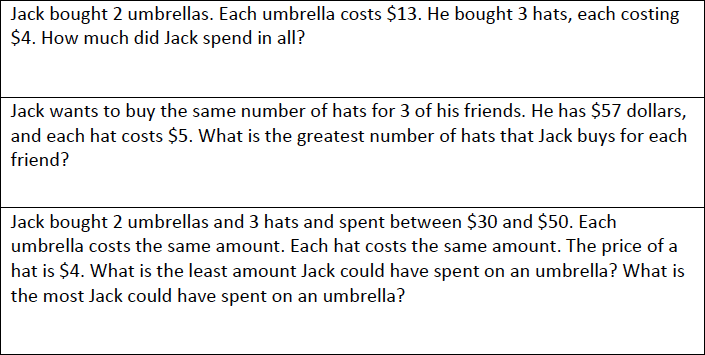Solve multi-step word problems posed with whole numbers and having whole-number answers using the four operations, including problems in which remainders must be interpreted. Represent these problems using equations with a letter standing for the unknown quantity. Assess the reasonableness of answers using mental computation and estimation strategies including rounding.
[divider] [/divider]Students are able to…
- Solve multi-step word problems involving all four operations using models and pictures.
- Interpret remainders within division problems.
- Explain solutions and process in which they solved the problem.
[divider] [/divider]Students are able to…because teachers…
- Provide opportunities for students to solve multi-step word problems involving all four operations.
- Provide opportunities for students to solve problems that include division with remainders.
- Facilitate discussion on the meaning of a remainder and what it represents in a problem-solving situation.
[divider] [/divider]Questions to ask students:
- See if students can correctly identify the operation(s) of a given story problem.
- Sample problem: Lance bought a package of 26 batteries. Each remote-controlled race car takes 4 batteries. How many race cars can Lance fill with batteries?
- Sample answer that indicates understanding: Student uses numbers, pictures or manipulatives to solve 26 divided by 4 equals 6 with 2 batteries left over.
- Sample answer that indicates an incomplete understanding or a misconception: Student does not recognize there are batteries left over or mistakenly answers 7 because they included the 2 batters to complete a new race car.
- Follow-up question: What does the 2 represent in the problem above?
- Sample answer that indicates understanding: 2 batteries left over that will not complete a race car, because it needs 4 batteries.
[divider] [/divider]FSA Notes:
Cognitive Complexity Level: 2: Basic Application of Skills & Concepts
Achievement Level Descriptors:
2- solves one-step word problems (which do not include remainders) using the four operations with simple context and scaffolding where the sum, difference, product, or quotient is always the unknown
3- solves two-step word problems (including interpreting remainders) using the four operations, where the unknown is in a variety of positions, and can be represented by a symbol/letter
4- solves three-step word problems using the four operations; recognizes the reasonableness of answers using mental computation and estimation strategies
5- solves multistep word problems with multiple possible solutions and determines which would be the most reasonable based upon given criteria
Assessment Limits:
Items requiring precise or exact solutions are limited to:
- addition and subtraction within 1,000.
- multiplication of 2‐digit by 1‐digit or a multiple of 10 by a 1‐digit.
- division of 2‐digit by 1‐digit.
Items may contain a maximum of 3 steps.
Items involving remainders must require the student to interpret and/or use the remainder with respect to the context.
Variables must be represented by a letter, and variables must be defined or described in the context.
[divider] [/divider]Additional Resources:
Additional in depth content knowledge
Blog Post: Helping students problem solve instead of “number shopping”
Video: Using the four operations to solve multi-step word problems and practice
Khan Academy: Multi-step Estimation Word Problems
Khan Academy: Represent Multi-step Word Problems Using Equations
[divider] [/divider]Sample Formative Assessment Tasks:

